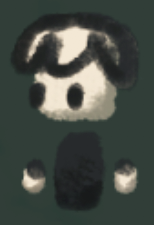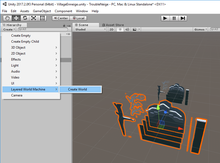Trouble Neige
| Trouble Neige | |
|---|---|
|
Échantillon de la photographie de village de Noël 2017. |
|
| Developer(s) | TroubledGames |
| Publisher(s) |
|
| Designer(s) | Suzanne Gomont & Élie Michel |
| Programmer(s) | Élie Michel |
| Artist(s) | Suzanne Gomont |
| Writer(s) | Suzanne Gomont & Élie Michel |
| Composer(s) | John Cage |
| Platform(s) | |
| Release | January 7, 2018 |
| Genre(s) | Plateformer, Interactive Tale |
| Mode(s) | Single-player |
Trouble Neige is a plateformer video game developed by the French independent team TroubledGames and released as a first beta demo in January 2018. It is available both as a desktop game, with Windows, Mac OS X and Linux support, and as a web game.
Contents
[hide]TroubledGames[edit]
TroubledGames is a French collective founded in December 2017 bringing together Élie Michel and Suzanne Gomont, to the honor of the video game creation and the desire to create poetic worlds. That's how they worked first on a reinterpretation of the famous godzilla figure in ragdoll, until they realized that this game was not worth much that it would be too complicated to put in place, and that certainly had to move on. Then began the design of Trouble Neige.
Pitch[edit]
Trouble Neige is a hypersensitive child living in an apathetic and overprotective microcosm. Forced to one day leave his village, he sets out to discover the outside world where he will have to learn to live with his different states of mind.
Chapter 1 : Drů (pilot episode)[edit]
Drů is the first chapter of Trouble Neige and its pilot episode. This chapter relates the departure of Trouble Neige from his origin village. Unlike the hero, its villagers are more apathetic and behave in a regulatory and serene way. The sheeps are finally the only characters of the village seeming really sensitive. This discrepancy between the sensibility of sheep and the functional behavior of villagers is maybe for the designers of the game a way to denounce the alienation of human beings in their work, thus repressing all the emotional wealth they embody. But on the other hand the village of Drů is still rather happy: protected from the dangers of the outside and living in self sufficiency, its villagers feeding exclusively on wheat and reproducing a precise schema of cycles of work and sleep have reached the state of psychological, intellectual, moral tranquility obtained by the rejection of all preoccupation. However, this pattern of quiet life doesn't seem to correspond to Trouble Neige which disturbs this world by its emotional excesses : angry or sad.
Gameplay[edit]
Depending on the circumstances, the player may change his environment by changing his mood. Each of these environments allows the player different interaction. It is by switching between these different worlds that he will solve the game's puzzles.
Levels[edit]
The underlying tale splits up into six chapters all leading to the discovery of a new mood world. The particularity of Trouble Neige is that the organisation of these chapters is not sequencial and and rather determined by the moods that the player decides to react with in the previous levels.
The pilot episode illustrates this with its tutorial sequence, and the whole game will follow the same design at a higher scale. Hence the two alternative endings of this first episode. The interest of this scheme would be to immerse the player to generate through these choices his emotional involvement.
Chapter 1 : Drů[edit]
In Chapter 1, the player has access to three environments:
The basic world where the game start is the comfort environnement. It is snowy and the the player has no particular power in this world.
Then the other two environments correspond to two strong emotions of Trouble Neige :
- the anger environnement that is on fire : in this one, the player can destroy some volumes, but there are also peaks that prevent access to certain areas.
- the sadness that is under rain : in this one, the player can trigger the rain touching clouds.
Production[edit]
Inspiration[edit]
Trouble Neige is the story of a child discovering the outside world, and in this optic took inspiration from some Travelers' tales from the Enlightenment, like Gulliver's travel or Zadig.
The game intends to trigger strong sentimental reactions for the player. This is first obviously suggested by the explicit manipulation of feelings and moves as a primary mean of action on the environment, but there is also an implication of the player caused by the actual forks that chosing one reaction over an other applies on the story. Reacting with anger may eventually have consequences later on in the story.
Artistic direction[edit]
The artistic direction of the game interprets aesthetically the states of soul in a primary way. Thus, in all simplicity the anger is associated with fire and red, and sadness with water and blue. This graphic choice may seem annodin but see its semantic depth is not less. Indeed, just as elements like fire, water or earth are in many cultures the pillars of our material world, just as red, blue or yellow are the primary colors in painting, sources of all other, the emotions are taken in this game as the source of what makes us a human. We might think that all this blah is big bullshit for writing more lines but it would be fooling you and refusing to consider all the greatness of simple things.
Technical curiosities[edit]
World transition[edit]
The world transition is operated through portals merging view from multiple cameras in an organic way. This was one of the challenges that the team had to overcome. After trying to stack cameras and apply filters to some of them only, a more efficient choice had been to turn toward rendering into textures and write a final composition shader.
Level design pipeline[edit]
Since the Full version of Trouble Neige relies mostly on level design, the basis for a strong design production pipeline have been set. A so-called Layerd World Machine plugin was developped and enabled the team to quickly iterate. This plugin loads automatically every images contained in a folder as a set of planes, of which relative positions are determined thanks to a precise file naming convention. Thus, the artistic team was able to previzualise the final ingame render of its design.
The overall pipeline is still in development for the future developments of the game. It still needs some additional tools for a better productivity, but this first step is important to design the needs for those pipeline tools and the different game logic bricks (explosions, portals, etc.)
Reception[edit]
Box Office[edit]
The Beta version of Snow Trouble is not supposed to bring in a single penny, but the game's creators expect to crumble in glory and wealth from one day to the next.
Critical response[edit]
Canard PC French magazine devoted mainly to video games on PC
"It was a long time since I had not seen such a complete game, as much on the playful way as in its psychological depth, and we feel that the game is finished to the smallest details. It is for me actually a masterpiece."
Jonathan Blow game designer and developer, founder of the Indie Fund
"Good game."
Kevin random player of the world wide web
"Too disappointed, the beta weighs very heavy for no more than two minutes of play. Game design is shit the level design worse. In addition, we can almost not play: collisions block the character all the time..."
Dan Da Rocha & Henry Hoffman Hue game designers
"It's obvious that the TroubledGames team plagiarized our game, but not so well. That's all we have to say."
Kevin random player of the world wide web, yes, still him
"On the other hand it is true that Hue was really a fabulous game. A remarkable platform puzzle game !"
Jean Zeid French game specialist and diarist on France Culture
"We can clearly see the strong Spinozist inspiration of Trouble Neige, who has to first let his emotions drive him through life but then uses it as an action lever. This merge of the body and the soul into a single dimension gives us a unique perspective of life. It's almost a video game reinterpretation of Kieślowski's Three Colors that TroubledGames Studio is giving us today!"
Piers Bishop Main reviewer at ATI
[Fill here !]
Distinctions[edit]
Récompenses[edit]
Best Music, for the adaptation of John Cage's 4'33" to Trouble-Neige environment.
Nominations[edit]
...

